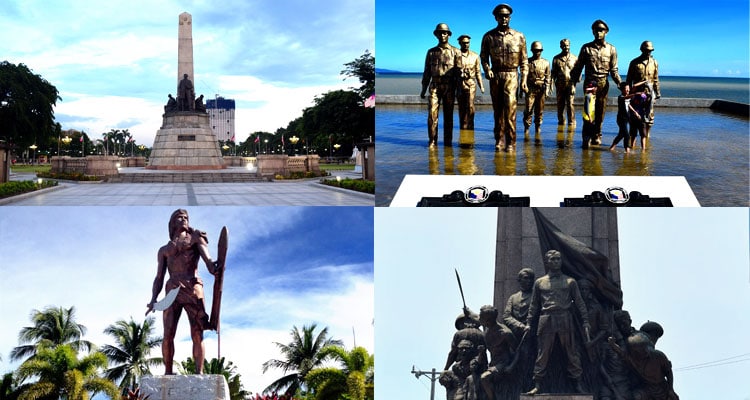
The Philippines is not only an archipelago with beautiful beaches, colorful festivals and hospitable people but also a country that is rich in historical heritage and landmarks. If you are travelling across the islands of the Philippines, you will not only be travelling through different places but also through different historical points in time. Here are 12 famous monuments and shrines in the Philippines that you can add to your travel bucket list.
1. Rizal Monument (Bantayog ni Jose Rizal)
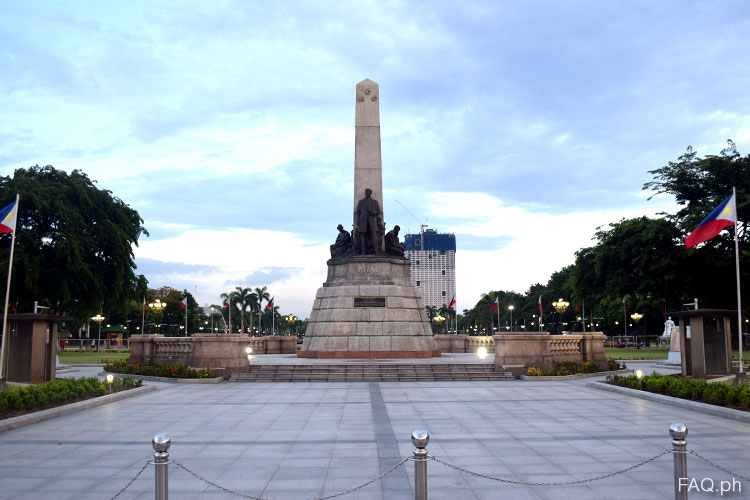
The monument of Rizal in Rizal Park or Luneta. This picture was taken on June 27, 2015. Photo by FAQ.ph
Basic information:
Location: Rizal Park (Luneta), Manila
Designer: Richard Kissling
Date of inauguration: December 30 , 1913
Dedicated to: To the memory of José Rizal, patriot and martyr.
Why you should visit it:
The monument of Rizal in Rizal Park (Luneta) is considered by many as the most popular, most visited and most photographed monument in the Philippines. It housed the remains of Jose Rizal, a Filipino nationalist, novelist, poet, journalist, ophthalmologist, and a national hero.
Rizal wrote the novels Noli Me Tangere and El Filibusterismo to expose the cruelty and injustice of the Spanish ruling government in the Philippines during his time. Because of his revolutionary writings, he was executed by a firing squad in Luneta on December 30, 1896.
There are at least 118 Rizal monuments in the Philippines and at least 10 in the other parts of the world. There’s even a replica of the Rizal monument in Luneta in Madrid, Spain. Read this article to learn more interesting facts about the monument of Rizal.
2. Bonifacio Monument (Monumento)
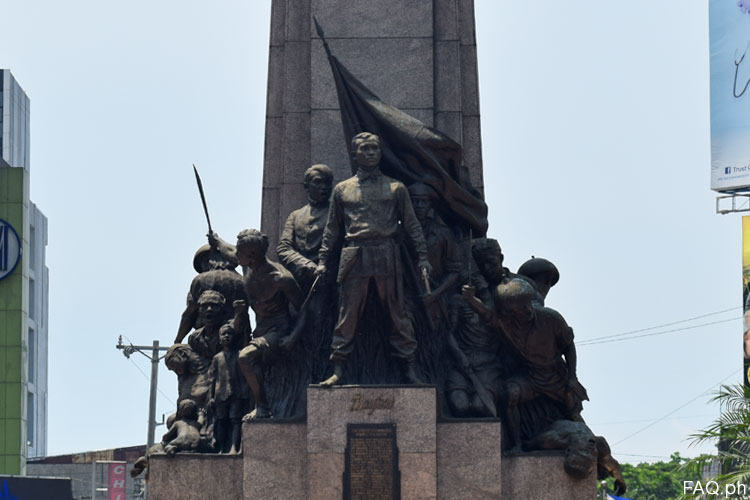
The Bonifacio Monument or Monumento in Caloocan City, Metro Manila. Photo by FAQ.ph
Basic information:
Location: Grace Park, Caloocan City, Metro Manila
Designer: Guillermo Tolentino
Date of inauguration: November 30, 1933
Dedicated to: To the memory of Andrés Bonifacio, the founder and Supremo of the Katipunan.
Why you should visit it:
Andres Bonifacio is popularly known as the father of the Philippine Revolution, and the founder and Supremo of the Katipunan or the Samahang Kataastaasan, Kagalanggalang Katipunan ng mga Anak ng Bayan (KKK). He is an icon of bravery and pride of the Filipinos.
The monument is one of the most beautiful works of art in the Philippines. It was designed by national artist Guillermo Tolentino, who also sculpted the famous University of the Philippines’ Oblation statue.
An important historical and cultural landmark in the Philippines, the monument has twenty-three figures, including Emilio Jacinto (popularly known as the brains of the Katipunan ) and the three martyred priests Mariano Gomez, Jose Apolonio Burgos and Jacinto Zamora (well known by many Filipinos as the GOMBURZA).
3. Lapu-Lapu Shrine
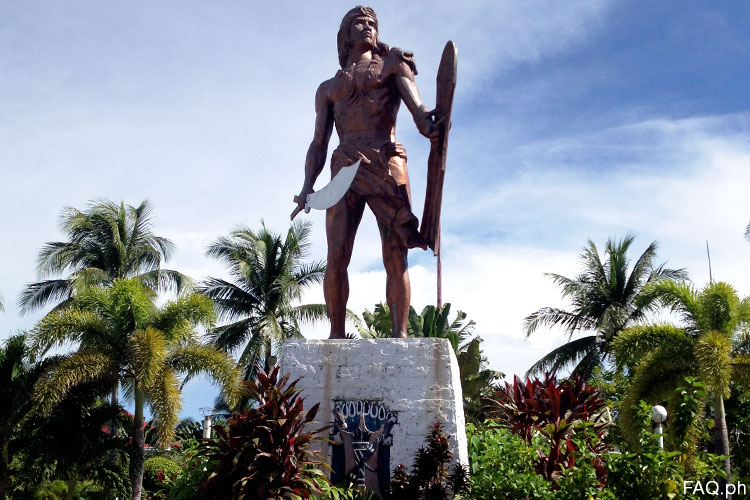
The monument of Lapu-Lapu in Liberty Shrine or Mactan Shrine. Photo by FAQ.ph
Basic information:
Location: Liberty Shrine, Punta Engaño, Lapu-Lapu City, Cebu
Dedicated to: Lapu-Lapu, a native chieftain of Mactan who defeated Magellan in the battle of Mactan in 1521.
Date built: Sometime in 1969 through RA. 5695
Why you should visit it:
Lapu-Lapu is considered as the first Filipino hero who successfully defended the Philippines from the Spanish invasion. He’s a symbol of courage and success in defeating enemies. In fact, his image is the central figure in the seal of the Philippine National Police and the Bureau of Fire Protection.
He is best known as the hero of the Battle of Mactan on April 27, 1521. The battle of Mactan stopped the invasion of Magellan in Cebu and delayed the Spanish occupation of the islands by over forty years until the expedition of Miguel López de Legazpi in 1564.
The monument of Lapu-Lapu is located in Liberty Shrine (Mactan Shrine), where the historic battle of Mactan took place at dawn on April 27, 1521. The area is also the place where Magellan Shrine and the marker of the spot the Portuguese conquistador was killed are located.
4. Magellan Shrine
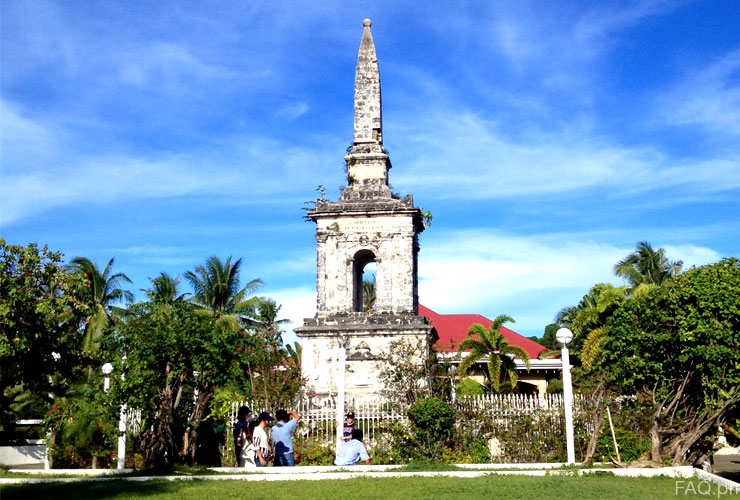
The monument of Ferdinand Magellan in Libery Shrine or Mactan Shrine. Photo by FAQ.ph
Basic Information
Location: Liberty Shrine (Mactan Shrine), Punta Engaño, Lapu-Lapu City, Cebu
Dedicated to: Portuguese explorer Ferdinand Magellan
Date built: 1866
Why you should visit it:
The monument of Magellan is the oldest in this list. It was built in 1866 – that makes the monument almost 150 years old now. The monument or shrine of Magellan is just a few steps from the statue of Lapu-Lapu. Both monuments and other important markers of events that happened during the historic battle of Mactan are found in Liberty Shrine or Mactan Shrine.
Ferdinand Magellan may be remembered by Filipinos as an enemy of the legendary hero Lapu-Lapu but the Portuguese explorer is also recognized by many as the man who brought Christianity in the Philippines.
The Portuguese explorer is also recognized by the world as the one who organized the Spanish expedition from 1519 to 1522 that resulted to the first circumnavigation of the Earth. A few steps from the monument of Magellan is a marker on the exact spot where the Portuguese explorer was killed during the Battle of Mactan.
5. Leyte Landing Monument
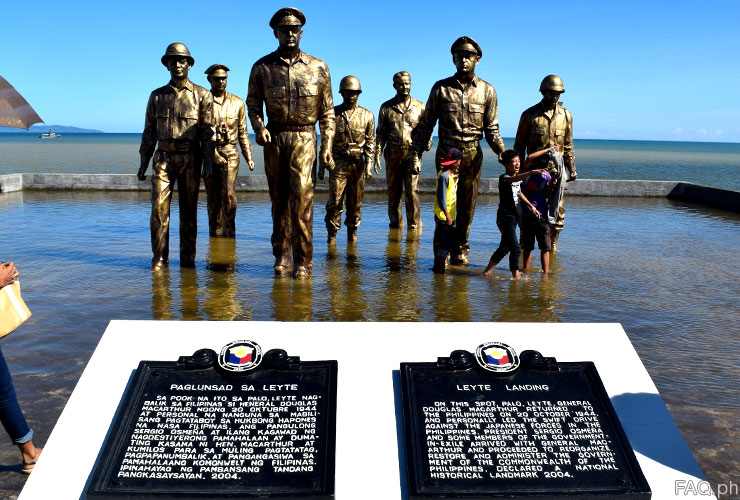
The Leyte Landing Monument or MacArthur Monument in Palo, Leyte. Photo by FAQ.ph
Basic information:
Location: MacArthur Landing Memorial Park, Palo, Leyte
Designer: Anastacio Caedo
Date of inauguration: October 20 1981
Dedicated to: General Douglas MacArthur, his entourage, and all the soldiers who fought and died in the battles of Leyte during the World War II
Why you should visit it:
MacArthur Landing Memorial Park in Palo beach was the site where the Allied Forces led by General Douglas MacArthur landed in Leyte on October 20, 1944. The monument also reminds us the fulfillment of MacArthur’s iconic words and promise “I shall return”. The fulfillment of that promise was the start of the Leyte invasion and his campaign to liberate the Philippines from the Japanese occupation during the World War II.
This historic event also led to the naval battle between the Japanese Imperial Navy and the US Navy (with the help from the Australian Royal Navy). The Battles of Leyte Gulf is recognized by many historians as the largest naval battle in history.
The Leyte Landing monument is composed of seven double-life-sized bronze statues of General Douglas MacArthur, Philippine President Sergio Osmeña, Lieutenant General Richard Sutherland, Brigadier General Carlos P. Romulo, Major General Courtney Whitney, Sergeant Francisco Salveron and CBS Radio correspondent William J. Dunn.
The monument also resembles the iconic photo of MacArthur and his entourage during the historic A-Day Landing as captured by Gaetano Faillace.
6. Sandugo (Blood Compact) Shrine
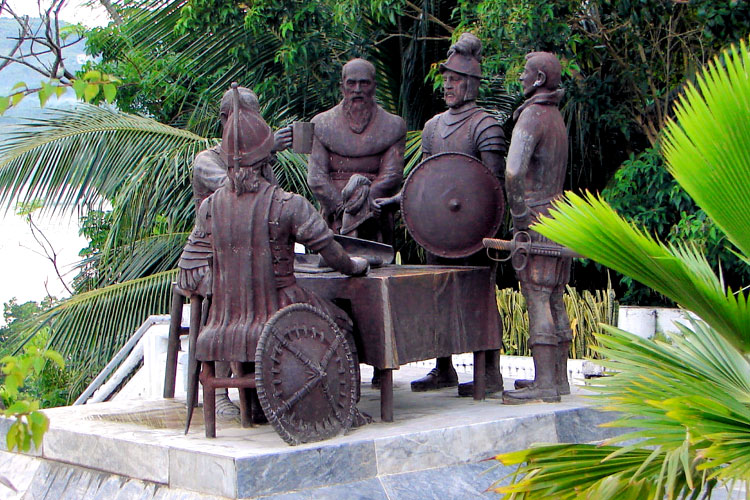
The Sandugo (Blood Compact) Monument in Barangay Bool, Tagbilaran City, Bohol. Photo by P199 at Wikimedia Commons
Basic information:
Location: Barangay Bool, Tagbilaran City, Bohol
Designer: Napoleon Abueva
Dedicated to: The peace pact between Datu Sikatuna and Miguel López de Legazpi in 1565
Why you should visit it:
The province of Bohol in Visayas is not only home to the magnificent Chocolate Hills and clear water beaches but also to rich historical sites. One of the most famous landmarks and historical sites in the Philippines is the site of the Blood Compact (Sandugo) between Datu Sikatuna and Miguel López de Legazpi in 1565 to insure the friendly relations between the Spaniards and Filipinos.
Among the monuments in this list, the Blood Compact shrine commemorates friendship rather than battles or wars.
The Blood Compact monument is one of the works of Napoleon Abueva, a Filipino national artist and also called as the “Father of Modern Philippine Sculpture”.
7. Dambana ng Kagitingan (Shrine of Valor)

Dambana ng Kagitingan (Shrine of Valor) cross in Mount Samat, Pilar, Bataan, Philippines. Photo by Diego Roxas at Flickr.
Basic information:
Location: Mount Samat, Pilar, Bataan, Philippines
Designer: Lorenzo del Castillo and Napoleon Abueva
Date built: 1970
Dedicated to: The Soldiers who fought for freedom in the Battle of Bataan.
Why you should visit it:
Mount Samat in Bataan was the site where the Philippine and American soldiers took their last stand against the invading Japanese forces in the Battle of Bataan. After a three-month battle, Bataan fell and surrendered to the Japanese on April 9, 1942. This Japanese victory led to the infamous Bataan Death March that involved 60,000–80,000 Filipino and American prisoners of war. The march resulted to more than 20,000 dead Filipino and American prisoners of war.
The Shrine of Valor was built not only to honor the gallantry of the Filipinos who fought in the Battle of Bataan but to honor all the brave soldiers who fought and died fighting for our freedom during the Japanese invasion.
To commemorate and honor the heroism and bravery of the soldiers who fought the Japanese invaders in the Battle of Bataan, the Philippine government declared April 9 as a national holiday. The day is known as Araw ng Kagitingan or Day of Valor.
8. Sultan Kudarat Monument

The monument of Sultan Kudarat in front of the Capitol building of the province of Sultan Kudarat. Photo by Manilaoldtimer.net.
Basic information:
Location: Isulan, Sultan Kudarat
Dedicated to: Sultan Kudarat, the Muslim brave hero and Mindanao’s most powerful ruler.
Why you should visit it:
Sultan Muhammad Dipatuan Kudarat, popularly known as Sultan Kudarat, is considered as the greatest Sultan of Maguindanao and the most powerful Sultan of Mindanao.
His monument located in front of the Provincial Capitol building of Sultan Kudarat is a testament of his bravery, ingenuity and relentlessness in conquering Mindanao and other parts of the Philippines from the authority of Spain.
The sultan of Maguindanao never allowed the Spaniards to conquer his sultanate. That is the reason why Spain failed to invade the whole of Mindanao and convert the natives to Roman Catholics.
The valiant ruler of Mindanao was declared a national hero during the presidency of Ferdinand Marcos.
9. Pinaglabanan Shrine and the Spirit of Pinaglabanan

The Spirit of Pinaglabanan Monument in Pinaglabanan Shrine, San Juan, Metro Manila. Photo by Ramon FVelasquez at Wikimedia Commons.
Basic information:
Location: N. Domingo corner Pinaglabanan Street, San Juan, Metro Manila
Designer: Eduardo Castrillo (designer of the Spirit of Pinaglabanan monument)
Date built: 1974
Dedicated to: The brave Katipuneros who fought and died in that battlefield.
Why you should visit it:
Pinaglabanan Shrine commemorates the Battle of San Juan del Monte, the first attempt of the Katipuneros led by Andres Bonifacio and Emilio Jacinto to fight the Spanish forces in late August of 1896.
Although the battle of San Juan del Monte was won by the Spaniards, the Katipuneros, who were only armed with bolos and homemade guns, did not lose their spirits. The guts and bravery of the Filipinos who fought during the battle sent a warning to Spain that their colonization of the Philippines will soon be over.
The five-hectare Pinaglabanan Memorial Shrine includes the Museo ng Katipunan, the Battle of Pinaglabanan statue (statue of a woman supported by two children, holding up a bolo), and the monument of the Spirit of Pinaglabanan (the shrine’s centerpiece which is a statue of elongated figures created by Edgardo Castrillo). For more interesting information about the shrine, read 15 Reasons to Visit Museo ng Katipunan-Pinaglabanan Memorial Shrine.
10. Balangiga Encounter Monument

The Balangiga Encounter Monument in Balangiga, Eastern Samar.
Location: Balangiga, Eastern Samar
Designer: Napoleon Abueva
Date built: September 28, 2003
Dedicated to: The heroism of the local freedom fighters in Samar
Why you should visit it:
The Balangiga Encounter Monument reminds us that Filipinos will not back down to fight for freedom against any foreign invader – even against the mighty American forces.
On September 28, 1901, the church bells of Balangiga were rung to signal an attack by native bolo fighters from Balangiga and the nearby villages of Lawaan, Giporlos and Quinapondan that killed more than 50 US soldiers. The encounter, popularly known as the Balangiga masacre, was described as the United States Army’s worst defeat during the Philippine-American War.
The attack outraged Gen. Jacob Smith and instructed his men to kill all Filipinos who were capable of bearing arms, including boys over 10 years old. Thousands of locals were killed and homes were burned under Smith’s order.
The historic bells of the church at Balangiga were taken by the Americans as war booty. The bells have not yet returned to the town’s church even up to this day.
11. Edsa Shrine

The statue of Our Lady of Peace in EDSA Shrine, Ortigas Center, Quezon City. Photo by FAQ.ph
Basic information:
Location: Ortigas Center, EDSA corner Ortigas Avenue, Ugong Norte, Quezon City
Designer: Various artists
Date built: 1989
Dedicated to: The peaceful outcome of the People Power Revolution in 1986
Why you should visit it:
The EDSA Shrine was originally built to commemorate the events during the People Power Revolution and its peaceful outcome. The People Power Revolution (also called the EDSA Revolution or the Philippine Revolution of 1986) was a series of nonviolent demonstrations joined by over two million Filipino civilians including several political, military and religious personalities on February 22-25, 1986.
The people power revolution caused the departure of the dictator President Ferdinand Marcos and the restoration of the country’s democracy.
The Shrine includes the seven-meter bronze statue of Our Lady of Peace, sculpted by Virginia Ty-Navarro . It has also two chapels – the San Lorenzo Ruiz Chapel and the Chapel of Perpetual Adoration – where catholic devotees can offer a prayer.
12. People Power Monument
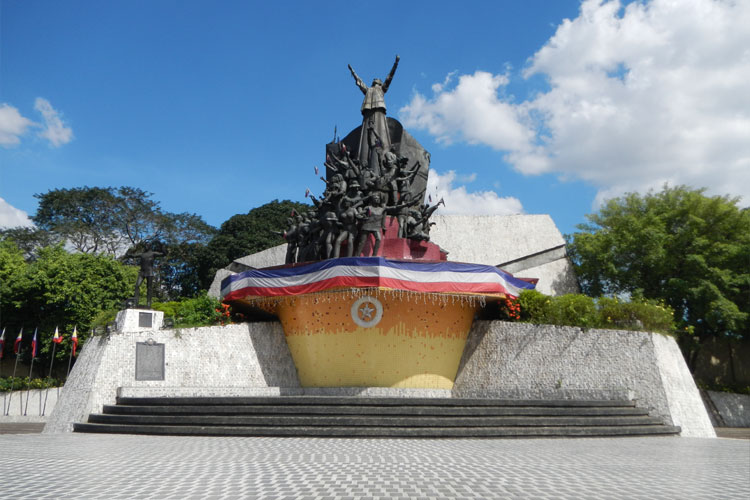
The People Power Monument located in the corner of Epifanio de los Santos Avenue (EDSA) and White Plains Avenue in Barangay Camp Aguinaldo, Quezon City. Photo by Ramon FVelasquez at Wikimedia Commons.
Basic information:
Location: Corner of EDSA and White Plains Avenue in Barangay Camp Aguinaldo, Quezon City
Designer: Eduardo Castrillo
Date built: 1993
Dedicated to: The brave Filipinos who marched on the streets of EDSA during the People Power Revolution in 1986
Why you should visit it:
The monument is about 0.89 kilometers from the EDSA Shrine. I think it’s a great monument to represent the People Power Revolution or EDSA Revolution in 1986.
The Filipinos earned the respect of the world when they successfully demonstrated the power of the people without using violence to end dictatorship and regain democracy in the Philippines.
Final thoughts
The historic monuments and shrines in the Philippines should remind us about the bravery, struggles and sacrifices made by Filipinos over hundreds of years to achieve the freedom that we enjoy today.
In the past, they took care of our independence. In this present time, can we take care of our freedom?
Our heroes paid bloods and lives. Let us visit them, and repay them with respect and honor.
So, how many of the monuments and shrines above have you visited already? What other historical landmarks in the Philippines can you add to this list? Feel free to make a comment below.
Other References:
A monument for the monument – NHCP.gov.ph
The Andres Bonifacion Monument – Malacanang.gov.ph
Sculptures of Napoleon Abueva
Bataan Death March – Wikipedia
Bataan.gov.ph
Sultan Muhammad Dipatuan Kudarat – WikiPilipinas.org
Pinaglabanan Memorial Shrine – NHCP.gov.ph
Eastern Samar townsfolk miss historic bells of Balangiga town – Inquirer.net
Balangiga massacre – Wikipedia
EDSA Shrine – WikiPilipinas
About Rig Man
Rig Man is a Filipino nationalist. He loves to travel through space and time – through astronomy, history and geology.
Hi guys halp! May alam ba kayong monument nabmagkatabi si dr. Jose rizal at si andres bonifacio?salamt!